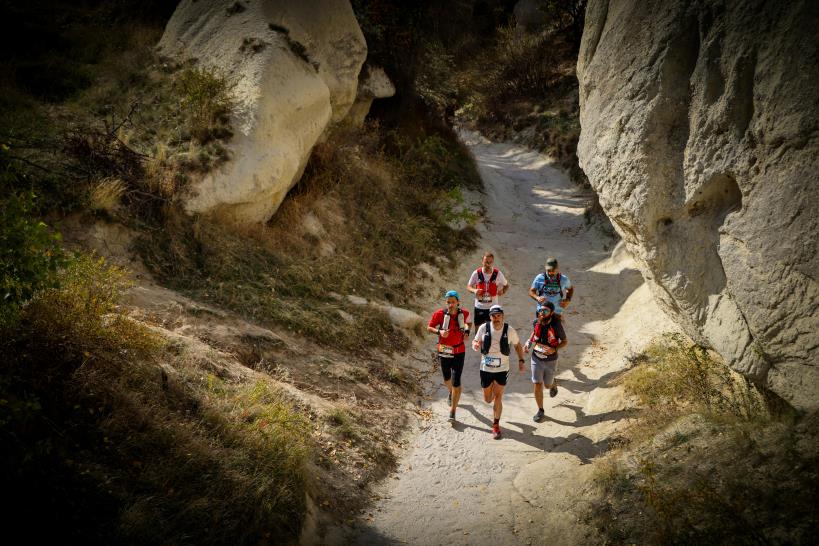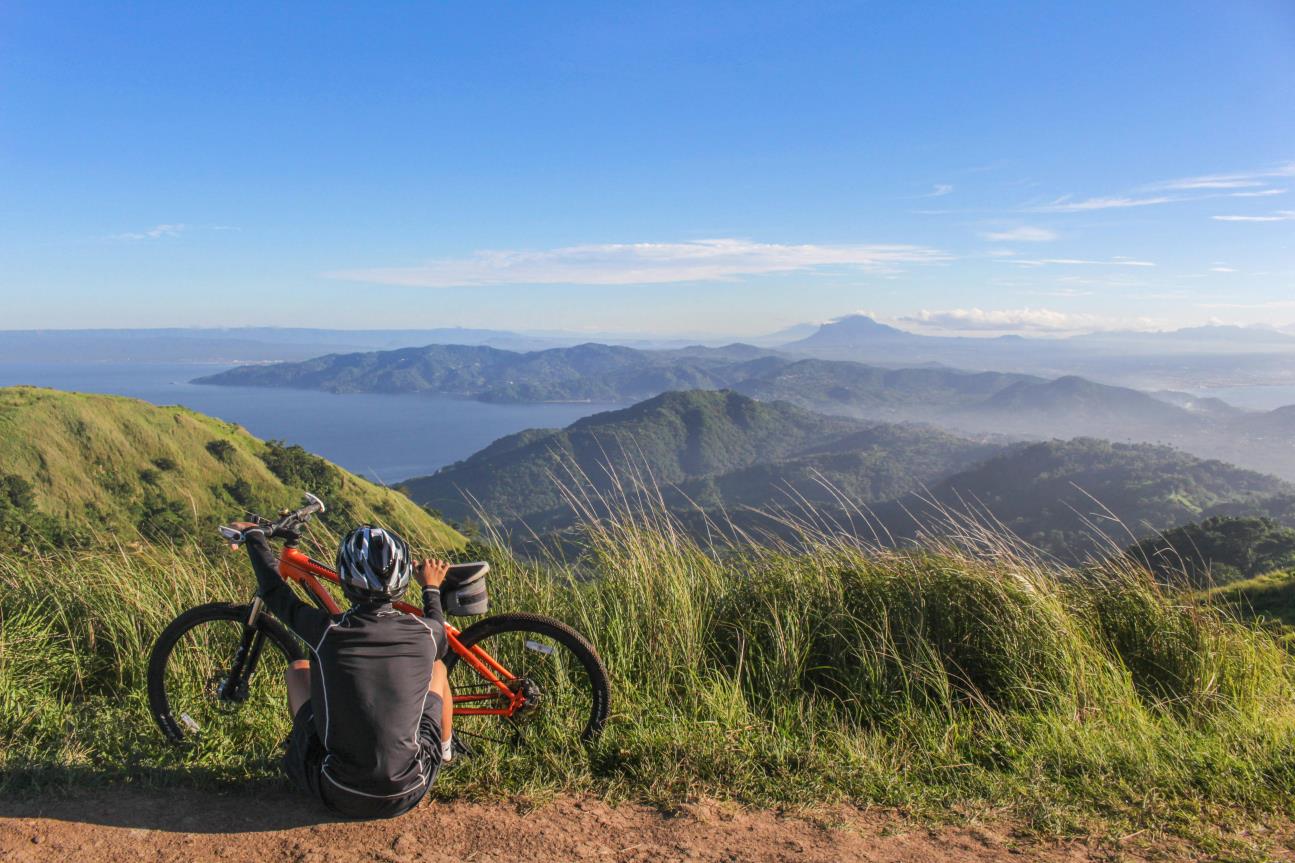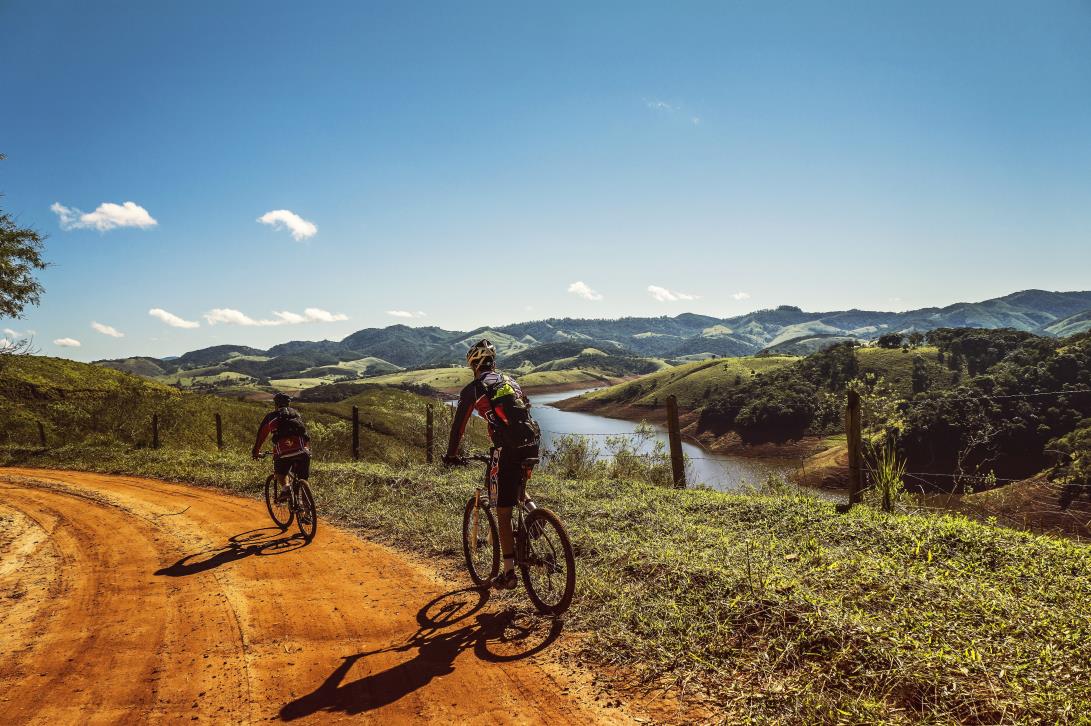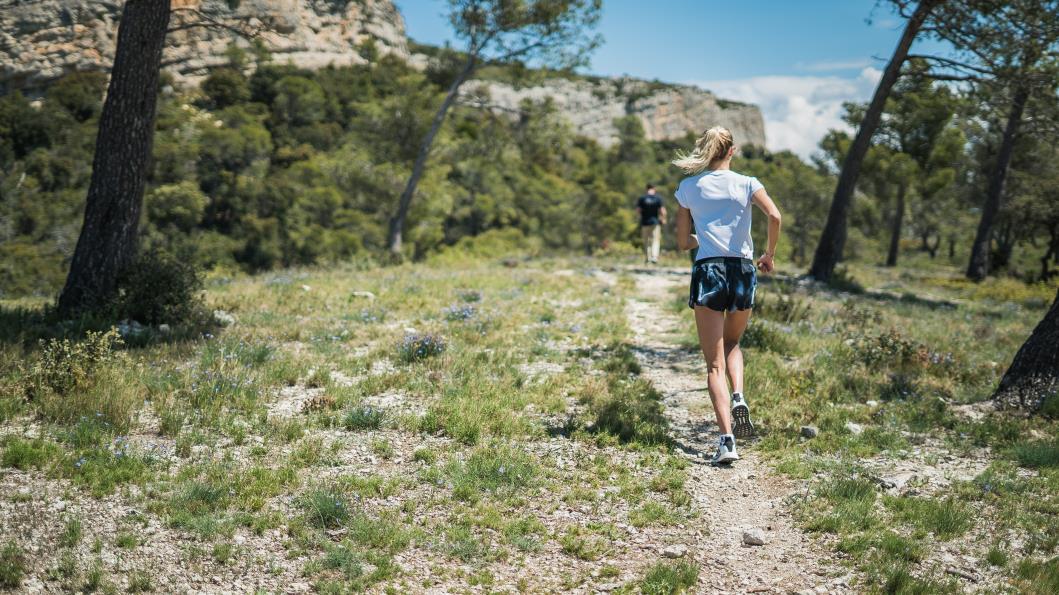Hitting the Hills in the Off-Season
 Karen Parnell
November 12, 2021
Karen Parnell
November 12, 2021
(1250x924px).png)
Hitting the Hills in the Off-Season
The off-season is an interesting time for triathletes. Some will seek out a race or two before the shortened season finishes like duathlons and running events; others have hung up their tri-suit and are focusing on next year.
Ultimately, there’s no ‘one rule fits all’, so you should feel free to experiment with how you spend the next few months. But there’s significant evidence to suggest that mixing up your training environments is beneficial for both the pure physical improvements, mental health benefits it can elicit and the variety of working out in different locations. It’s liberating to train over different environments. So maybe a time to hit the trails and don’t be afraid to get dirty!
The strength benefits from training off-road can’t be replicated in an indoor environment – nature gives us such great terrain and we should use it. Lace up your trail running shoes and dust off the mountain bike for this next phase of your training.
Benefits of Trail Running for Triathletes in the Off-Season
Hitting the trail—even a smooth gravel, dirt or woodchip path—works your muscles, tendons and ligaments (and more) differently than running on the road or treadmill. Running trails that head uphill or down you're not only building your cardiovascular engine, but strengthening quads, glutes, calves, and core, too. If you are new to running downhill or want to perfect your technique then here are some tips.
Let's take a look into the advantages of trail running for triathletes during the off-season and how it can be a game-changer for your overall performance.
1. Varied Terrain, Enhanced Strength
Trail running presents a stark contrast to the monotony of pounding pavements. The uneven surfaces, undulating terrains, and natural obstacles engage a wider array of muscles. This helps improve your overall strength and stability, particularly in your core, legs, and ankles. These enhanced muscle groups translate directly to more powerful strides and better stability during the running leg of a triathlon.
2. Improved Balance and Coordination
Navigating through trails requires a heightened sense of balance and coordination. The ever-changing terrain demands quick adjustments and precise movements, which can significantly improve your overall body control and proprioception. These skills are invaluable, especially during the transition from the bike leg to the run leg in a triathlon.

Get your FREE guide to Running Technique
3. Enhanced Mental Toughness
Trail running often presents unexpected challenges, from sudden elevation changes to navigating through narrow paths. These situations demand mental focus, adaptability, and problem-solving skills. By tackling such obstacles during the off-season, you'll develop a greater mental fortitude that can be a game-changer during the intense stages of a triathlon.
4. Reduced Risk of Overuse Injuries
Trail running offers a welcome break from the repetitive motions of road running. The constantly changing terrain encourages a more diverse range of movements and engages different muscle groups. This helps alleviate the risk of overuse injuries that can arise from the repetitive nature of running on flat, predictable surfaces.
5. Enhanced Cardiovascular Fitness
Trail running often involves steep ascents and descents, which can be an intense cardiovascular workout. The varied terrain and elevation changes provide an excellent opportunity to improve your cardiovascular endurance and muscular endurance. This can translate directly to more efficient running in a triathlon.
6. Connection with Nature and Stress Reduction
Running through scenic trails immersed in nature offers a mental and emotional boost. The tranquility of natural surroundings can provide a welcome respite from the hustle and bustle of everyday life. This sense of connection with nature can help reduce stress levels and promote mental well-being, which is crucial for maintaining a balanced and focused training routine.

Get your FREE guide to Running Technique
Time to Lace up those Trail Running Shoes?
Embracing trail running during the off-season is a strategic move for triathletes seeking to elevate their performance. The varied terrain, enhanced strength, improved balance, and mental toughness gained from trail running are invaluable assets that can directly impact your triathlon performance. Moreover, the joy of running through nature's trails can reignite your passion for training, making your off-season an exciting and fulfilling journey. So, lace up your trail shoes and hit the dirt - your next triathlon victory might just be waiting in the wilderness!
Download your FREE 8-Week Trail Running Training Plan.
Benefits of Mountain Biking in the Off-Season
Mountain biking is the ultimate way to increase your bike handling skills. The varied, technical terrain helps develop quick reflexes and a light-on-your-feet pedalling style. These two skills translate directly to road cycling and are especially valuable on high-speed descents.
Here are some of the many benefits of getting out on your mountain bike in the off-season or winter months:
1. Improved Strength and Conditioning
Mountain biking demands a unique set of skills, including balance, agility, and upper body strength, which may not be as intensely targeted during traditional triathlon training. The uneven terrain, steep climbs, and technical descents provide an excellent full-body workout. This can lead to improved muscle strength, especially in your core, arms, and shoulders, which are crucial for maintaining a strong and efficient posture during all stages of a triathlon.
2. Enhanced Technical Skills
Navigating through rugged terrains, steep descents, and tight corners on a mountain bike hones your technical skills. These skills can be directly transferrable to your triathlon cycling leg, giving you an edge over competitors who may not have this experience. You'll become more adept at handling your bike, making you a more confident and competent cyclist overall.

Get your FREE 31 structured Cycling Session Plans
3. Increased Cardiovascular Fitness
While mountain biking may not be as continuous as road cycling, the varying terrains and intense bursts of effort required for climbs and technical sections provide an exceptional cardiovascular workout – a super fartlek workout! This helps improve your endurance, allowing you to sustain high-intensity efforts for longer durations, which can significantly benefit your triathlon performance.
4. Mental Toughness and Focus
Mountain biking often requires quick decision-making and split-second reactions to changes in terrain. Negotiating obstacles and navigating technical sections demands heightened focus and concentration. These mental aspects of mountain biking can greatly enhance your mental fortitude and agility which is crucial during the demanding stages of a triathlon.
5. Reduced Risk of Overuse Injuries
Transitioning from the repetitive motions of road cycling to the diverse movements involved in mountain biking can help you alleviate the risk of overuse injuries. The varied terrain and constantly changing riding positions engage different muscle groups, preventing the excessive strain that can occur from repetitive motions.
6. Enjoyment and Motivation
Adding mountain biking to your training routine can inject a new level of excitement and enjoyment into your off-season. The sense of adventure and exploration that comes with riding through forests, trails, and mountains can reignite your passion for training. This renewed motivation can be a powerful driving force that keeps you committed and enthusiastic throughout the off-season.

Get your FREE 31 structured Cycling Session Plans
Time to Dust off your Mountain Bike?
Embracing mountain biking during the off-season can give you the edge as a triathlete come race season. It offers a unique blend of physical and mental benefits that complement and enhance your existing training regimen. By incorporating mountain biking, you'll not only improve your strength, endurance, and technical skills, but you'll also infuse a fresh sense of excitement and adventure into your off-season training. So, grab your mountain bike and hit the trails – your next triathlon victory might just be around the corner!
Off-Road training plans
on FinalSurge
8-Week Off-Season Hitting the Trails Plan
Bearing the benefits above in mind I have created an 8-week hitting the trials plan. This eight-week training programme includes a mix of training options, including going off-road as well as your standard pool, gym and road workouts. If you can find forest trails or parks with hills, try out these locations as soon as you can.
There’s is flexibility in this plan that means it can be adapted to all levels. If you’re still new to the sport, steer towards the lower end of the workout duration scale, while advanced athletes can push themselves with longer or more challenging sessions.
The plan includes:
- MTB cycling sessions
- Trail running
- Swimming sessions with drill videos
- Strength sessions to help avoid injuries
- Email access to your coach
Your purchase includes a PDF download plus access to the ChiliTri App. Once purchased we will activate your App access so you can have it delivered on your Apple device, Android device or PC.
The ChiliTri App gives you full access to training videos, detailed session plans, nutrition advice and more.
Would you like a free training plan? Claim your free plan or e-book.
Get your FREE guide to Running Technique
Get your FREE 31 structured Cycling Session Plans
Running training plans on FinalSurge
Running training plans on TrainingPeaks
Off-Road training plans
on FinalSurge
Karen Parnell is a Level 3 British Triathlon and IRONMAN Certified Coach, 8020 Endurance Certified Coach, WOWSA Level 3 open water swimming coach and NASM Personal Trainer and Sports Technology Writer.
Karen is currently studying for an MSc in Sports Performance Coaching at the University of Stirling.
Need a training plan? I have plans on TrainingPeaks and FinalSurge:
I also coach a very small number of athletes one to one for all triathlon and multi-sport distances, open water swimming events and running races, email me for details and availability. Karen.parnell@chilitri.com
Get your FREE Guide to Running Speed and Technique
Get your FREE Swim Workouts for Triathletes E-book
Get your FREE Open Water Swimming Sessions E-Book

FAQ: The benefits of trail running for triathletes and runners
What is trail running?
Trail running is a form of running that takes place on natural trails, such as dirt paths, forest trails, or mountainous terrain, as opposed to running on paved surfaces like roads or tracks. It involves navigating uneven surfaces, hills, and varied terrain.
What are the benefits of trail running for triathletes and runners?
Trail running offers several benefits for triathletes and runners:
- Enhanced strength and endurance: Trail running engages different muscles and challenges your body in unique ways compared to road running. The varied terrain, including hills, uneven surfaces, and obstacles, helps build lower body strength, stability, and overall endurance.
- Improved agility and coordination: Negotiating trails with changing surfaces, twists, and turns requires improved agility and coordination. Trail running can help develop these skills, making you a more well-rounded athlete.
- Reduced impact on joints: Trail running typically involves softer surfaces compared to pavement, which can help reduce the impact on joints and lower the risk of overuse injuries commonly associated with road running.
- Mental stimulation and stress relief: Running in nature and being surrounded by scenic environments can provide mental stimulation, reduce stress levels, and enhance overall well-being. Trail running allows you to connect with nature and enjoy the tranquillity of the outdoors.
- Enhanced proprioception and balance: Trail running requires constant adjustments to maintain balance and stability on varying terrains. This can improve your proprioception (awareness of your body's position in space) and overall balance, which can be beneficial for other sports and activities.
- Increased variety and enjoyment: Trail running offers a change of scenery from traditional road running. The exploration of new trails and natural surroundings can add excitement, motivation, and enjoyment to your training routine.
Can trail running improve my performance in triathlons?
Yes, trail running can improve your performance in triathlons in several ways:
- Increased leg strength and power: Trail running's challenging terrain can help build leg strength and power, which translates to better performance during the run portion of a triathlon.
- Improved mental resilience: Trail running requires focus, adaptability, and mental resilience due to the unpredictable nature of the terrain. Developing these mental skills can be beneficial for the demanding nature of triathlons.
- Better handling of varied terrain: Triathlons often include off-road sections or trail portions. Training on trails can improve your ability to handle uneven surfaces and varying terrains, giving you an advantage during the race.
How should I incorporate trail running into my training routine?
Here are a few tips for incorporating trail running into your training routine:
- Gradual transition: If you're new to trail running, start gradually by incorporating shorter trail runs into your weekly training schedule. Begin with flatter and less technical trails, then gradually progress to more challenging terrain as your fitness and confidence increase.
- Mix it up: Alternate between trail running and road running to enjoy the benefits of both. This can provide variety, work different muscle groups, and help prevent overuse injuries.
- Adjust expectations: Trail running may be slower-paced compared to road running due to the challenging terrain. Embrace the experience and focus on the journey rather than solely on speed or distance.
- Safety first: Pay attention to trail conditions, wear appropriate footwear with good traction, and be mindful of obstacles on the trail. Carry water, navigation tools, and let someone know about your trail running plans.
Are there any precautions to consider when trail running?
Yes, it's important to consider the following precautions when trail running:
- Trail conditions: Be aware of weather conditions, trail difficulty, and potential hazards. Adjust your pace and approach accordingly.
- Footwear and gear: Invest in trail-specific running shoes that provide good traction and stability. Consider wearing moisture-wicking clothing and carrying essentials like water, nutrition, a mobile phone, and a map or GPS device.
- Strength and stability training: Incorporate strength and stability exercises into your training routine to help prevent injuries and improve your ability to handle uneven terrain.
- Mindful running: Stay focused and attentive to your surroundings. Watch for roots, rocks, and other obstacles that may pose a tripping or slipping hazard.
Remember to consult with a healthcare professional or coach before starting any new training program, including trail running. Start gradually, listen to your body, and enjoy the experience of running in nature.
References
Trail Running for Beginners | REI Expert Advice
#trailrunning #mountainbiking #offseasontraining #triathlon #chilitri #swimmingtrainingplan #cyclingtrainingplan #runningtrainingplan #swimming #cycling #running
